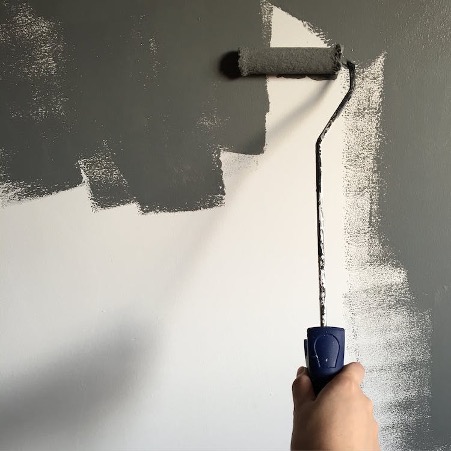
There’s a reason we fork out our hard-earned cash for professional painting services. Ultimately, skills pay the bills, and we’re left with the knowledge that our walls got the job done right.
But what if we could get in on some of those tricks and techniques?
Yes, painting goes beyond simply picking a brush up and going to town. Like any profession, there are tricks of the trade that professional painters use, making the job more efficient and effective. So what are they?
Below are eight of the best-kept secrets of professional painters, which you can learn and use to give your walls a perfect finish!
Paint in the Correct Order
When painting your interior, there is a specific order in which you should paint, and it’s important to stick to it.
A professional painter will almost always start with the trim, followed by the ceiling and finally the walls. It’s done this way as it’s more efficient to tape off the trim than the walls.
In addition to not having to be neat when painting your trim, it doesn’t matter if trim paint gets onto your walls. As the walls will be painted last, any accidental paint splashes will be soon covered up.
What you don’t want is to tape your walls and trim. Once you’ve painted your trim, wait for 24 hours and proceed to tape them. You can then move onto your ceilings and walls last.
Use High-quality Paint
You may be thinking that paint is just paint, and the price difference is solely due to the brand name. This is not the case, and a professional painter will always go for the high-grade stuff.
High-quality paint will cover better, last longer and be far more resistant to chips and cracks than its cheaper counterparts. In addition, it takes longer to dry and will leave fewer visible brush strokes on your surface.
Cheaper paints have low-quality pigments, meaning they’re thinner and will require more coats to get the job done – a big time waster.
Use this Technique to Avoid Lap marks
Lap marks are left over marks due to uneven paint drying. They’re unsightly and can also be difficult to fix without redoing the whole job.
To avoid these marks from forming in the first place, professional painters always wait until the existing paint coat is completely dry before applying the new. Furthermore, they maintain a “wet edge” on their roller, ensuring every stroke overlaps the previous one before the paint dries.
You can maintain a wet edge by painting your wall in one go. Begin by running your roller from top to bottom of your wall, gradually moving to the side with each stroke. Ensure your roller doesn’t become nearly dry as you reach the end of your wall as this will cause lap marks.
Prevent Paint Drips Once and For All
Paint drips are a great way to ruin your perfect finish. To prevent them from occurring, professional painters always use masking tape and plastic sheets.
Painter’s tape is particularly useful for taping around the edges of walls, window frames and doors, ensuring no paint ends up where it shouldn’t be. Plastic sheets are used to cover furniture and floors, meaning any accidental drips can be easily wiped away without leaving permanent marks.
When using painter’s tape, ensure it’s at least twice as wide as your trim. And when you’re done, remove it asap before your paint dries. Alternatively, you can wait 24 hours and remove it when your paint has dried. Just don’t pull it when it’s partially dry, as bits of paint may peel off with your tape.
Identify Imperfections with a Small Light Source
When painting, put a hand-held bulb against your surface. This ray of light will easily pick out any bumps, ridges and cracks that your eyes may miss.
By identifying these issues beforehand, you can fill and sand them in before you paint over them.
You’ll even want to fill in small holes, as painting over them will actually
accentuate them.Doing this will create an even surface that looks flawless when you’ve finished painting it.
Caulk Between Your Wall and Woodwork
When painting your woodwork and walls, apply acrylic latex caulk between both. Use a putty knife to remove excess caulk and apply with a dripless caulk gun. Both will save you time and give you a much more professional look.
Caulking will provide your walls with extra protection from moisture, fill any gaps between both surfaces and give you a beautiful finish that won’t crack or require extra filling over time.
Smoothen Your Walls After Each Coat
The best way to ensure a flawless finish without bumps and ridges is to sand between each coat. Doing so will make it easier to apply subsequent coats, and create a smooth finish that looks significantly better than if you hadn’t sanded at all.
Sanding will begin before and after applying primer, along with each coat of paint. Use a 180-220 grit sandpaper or a sanding sponge, which are classed as “non-clogging”. Once you’re done, clean your surface via vacuuming and wiping with a slightly damp cloth.
Don’t like Drop Cloths? Use Cardboard
Drop cloths are typically used, but they do have their limitations. They’re big, messy and even slippery, making it difficult to work in one area.
A great alternative are cardboard boxes, which you may already have lying around. Cardboard is perfect for small projects as it’s easy to cut, move and won’t slip if used correctly. This is why many painters set cardboard against the wall, and move it each time they finish a section.
Using these best-kept secrets of professional painters ensures your paint job looks perfect and lasts for years to come. Spend a little extra time during preparation and apply each of these tips, and you’ll have a beautiful finish that you’ll be proud of.
Good luck! There’s nothing more satisfying than the perfect finish. So take your time, prepare thoroughly and use these secrets to get it right the first time. Have fun painting!



